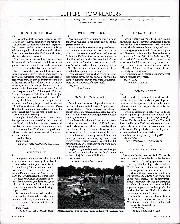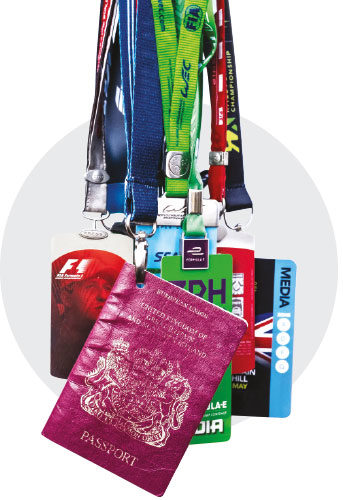
Follmer glories
Sir, I have just seen your list of the most versatile drivers and I have to say that you missed a driver who has done a lot more than some…

The front gardens of Goodwood House in Sussex are replaced by a frozen Alpine airfield. Instead of Tarmac and gravel, there is a hard ice layer and the hay bales that line the track during the Festival of Speed have morphed into large drifts of white snow. But one thing remains the same: the roar of engines as drivers battle to control their cars in tricky conditions and compete.
Welcome to the Ice GP, a unique and very cold celebration of hot metal, which took place in January in Zell am See, a mountain village of 9500 residents about an hour’s drive south of Salzburg. The resort nestles among Austria’s highest mountains and received more tourists this winter than it has for years. At first, things appear normal: skiers bustle around the streets, trudging towards the gondolas. The morning sun shines through the ridge of the mountains and the thermometer shows minus 11 degrees Celsius.
But the situation is not quite normal. In the background you do not hear the typical buzz of snow cannons, instead it is the roar of engines. Also moving around the narrow streets are Porsche 911 GT3s, a DTM-spec Audi RS5 or insanely expensive classics such as a 1938 Alfa Romeo 8C 2900 or the lightweight Porsche 356 from Abarth – cars typically seen only in the summer, or else in museums.
The visitors are not the usual ski crowd either: “That is a six-cylinder boxer,” I heard one say as a distant engine fired up.
“For £20, fans can go anywhere. Heroes like Walter Röhrl were close to the people”
The event focuses on a circuit, almost a third of a mile long, built on ice, fenced in by snow and floodlight poles. For professionals and amateurs who compete in five classes in a mass start, or else offset against each other.
The stars come with bonnets, gloves and long underpants: grand prix star Mark Webber, Le Mans 24 Hours winners Marc Lieb, Neel Jani and André Lotterer, WRC2 champion Jan Kopecký, Pikes Peak record holder Romain Dumas and Walter Röhrl, who announced via the loudspeaker that: “This is not any [Audi] S1 that I’m driving, but a 1985 Sport quattro from the Rally Monte Carlo.” You don’t get much better than Röhrl in a Group B monster. In the snow…

The event is the brainchild of Ferdinand A Porsche, named after his great-grandfather, the design genius behind the Stuttgart giant. So how did it come about? “One and a half years ago we stood in front of a 550 Spyder with a spiked tyre detached on the wall behind it. We asked ourselves why there were no more ice races?” The ‘we’ is Porsche and his university colleague Vinzenz Greger. The two are business partners and own a company, the Mid-20s, which organises track days for Porsche drivers.
“The Ice Race is the first time that we have had spectators, not just participants,” Porsche says. “It wasn’t hard to convince people to come here. Because it’s such a fun thing that no one had on the radar. [Sports car racer] Richard Lietz and Hans Stuck were the first people we asked. Both thought it was good. And if two Le Mans aces say that’s a great idea, then it can’t be so wrong.”
The idea of an ice race in Zell am See is not new. From 1937 on, horses raced here, then motorcycles and later cars drove over a snow-cleared circuit on the frozen lake. Porsche came to the lake with factory cars in the 1950s, driven by big names like Huschke von Hanstein. The ancestors of Ferdi Porsche and Vinzenz Greger also took part in the race.
“There used to be thousands of spectators and a lot of rambazamba [an Austrian term, similar to hullabaloo],” says Porsche.


Heavy snow caused occasional cancellations, but the event continued to run regularly until 1973, when Swedish speedway star Börje Sjöbom (Jawa) set a new lap record at 31.5sec, 71mph.
A tragic accident in 1974 brought a long-term end to racing, however. During pre-event preparations, two employees from the municipal building yard crashed through the ice in a Unimog. They were in the process of clearing the snow for the race. One saved himself by jumping clear, but his colleague drowned in deadly cold water.
The race lay dormant for the next 45 years, until it was resurrected by Porsche. Since 2001, the Zell am See airfield and the surrounding land have been owned by the Porsche family. And in fact the Pinzgau, as the region around Zell am See is called, is Porsche land. This is where the clan prefers to invest and spend their leisure time. The head of the family, Wolfgang, Ferdi’s father, is the chairman of the supervisory board and the face of the brand. Most of the time the Austrian resides in Zell. The family home is above a road tunnel on the southern shore of the lake, at the Schüttgut. Ferdinand Porsche discovered the mountain pasture there during a test drive, and during World War II the family retreated there. After the war, the first Porsche sports cars were assembled on the farm.
Ferdi knows how to put Porsche’s philosophy into practice: “We wanted to have old and new in the ice race. If you take a look around, you’ll see old combustion engines and electric cars – that’s a perfect fit for Porsche.”
The oldest car in the race was an Austro-Daimler ADR 6 Torpedo from 1929, the youngest a brand-new VW Polo GTI R5 – there are 90 years of motor sport history and development between the two.

For an entrance fee of just £20, fans can go anywhere. Greger and Porsche decided not to have large VIP areas. So heroes like Walter Röhrl were close to the people. And, wherever the rally legend appeared during the event, there was always a crowd of people around him. Yet he was unaffected by the attention and signed autographs as he was looking forward to driving: “It’s always fun to be able to get into the past like this. You immediately feel 30 years younger,” he said.
Audi factory driver Daniel Abt had fun in his first-generation Formula E car: “It goes really well on snow, we should race on it,” he said. “Stupid questions about the battery and the cold raised a tired smile, though: “So far I’ve only seen combustion engines that won’t start!”
Abt made an attempt at traditional skijoring, in which a skier is pulled by his car. Professionals even let the skier stabilise the rear end and help to turn it at the right time by shifting their weight. Freestyle ski racer Benedikt Mayr was towed by Abt along the course, and he knew what was important for the technique: “I have to make sure that the rope is pulling tight,” he said. But he did once give Abt, who was at the wheel pulling him, a fright: “Suddenly I didn’t see Bene in the rear-view mirror anymore,” said Abt. “Then I thought to myself: ‘Ohhhh s**t!”
After a few practice laps, Mayr even performed tricks on the ice. “In the end, I could even have driven the other way around,” added Abt.

Other star drivers had less fun. René Rast also drives for Audi, and took a run in his DTM car. The 2017 DTM champion was at one point in sixth gear, yet travelling at only 10mph and still couldn’t get the power to the ground. “We even had extra tyre spikes, which were made by hand,” he said. Due to the shape of the RS5 DTM’s wheel arches, the spikes were designed not to foul the car’s arches, but were too short properly to bite into the ice. “Daniel drove around the bend with one hand and his finger in his nose,” added Rast. “And I almost slipped into Walter Röhrl’s car!”
“I only have just under 60bhp, so it’s difficult to cause too much excitement, but I loved it”
Mark Webber, who has been in Austria regularly since his Red Bull days, grinned in the sun. The Australian was allowed to drive a classic red Porsche 356: “I only have just under 60bhp, so it’s difficult to cause too much excitement, but I loved it.”
But what would happen if he crashed the million-dollar baby? “We better not talk about that.” Instead, Webber was left randomly wondering about David Hasselhoff’s popularity in the Alpine republic as the US actor/singer suddenly appeared in the audience, causing a surprise commotion. ‘The Hoff’ was in the area for a concert and was stuck because of a roadblock. But this time he wasn’t the main attraction – the true stars were the racing cars.

One example was the original Porsche Fetzenflieger, which one-armed Otto Mathé used to annoy the factory teams in the 1950s. He fashioned the car himself from VW parts and a Porsche engine. At the ice race in Zell in 1956, Mathé covered the four kilometres in just 157 seconds, a record-breaking time. In order to be able to change the spark plugs on both sides more quickly if necessary, he left the side panels open. However, he had to cover them somehow and often fitted a linen cover.
It became a regular occurrence that the flammable cover caught fire and the shreds (in German: fetzen) flew away along the run, contributing to the car’s historic nickname. Stories of it are still told today. Maybe the same will soon apply to the GP Ice Race – to be continued next year, when Ferdinand Porsche puts out the call again.